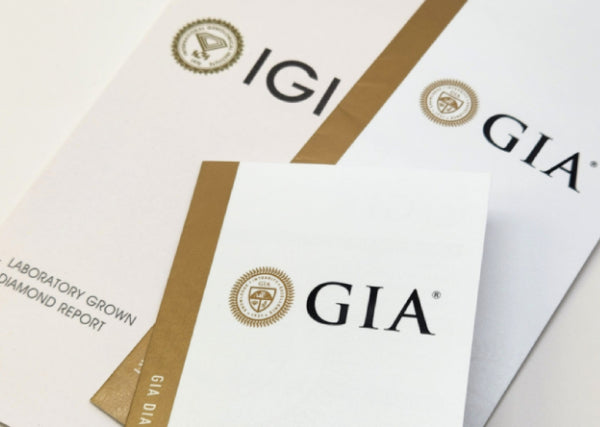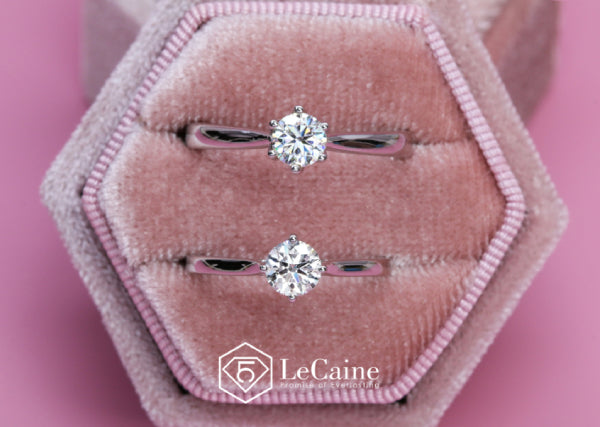Are Lab Diamonds Indistinguishable from Natural Ones?

Table Of Content
As lab-grown diamonds grow in popularity, more couples are asking a simple yet important question: Can you tell the difference between a lab-grown and a natural diamond? On the surface, both stones shine with stunning brilliance and feel identical to the touch. But underneath that sparkle lies a fascinating story of science, ethics, and innovation.
For anyone exploring lab-made diamond rings, or selecting a solitaire ring in Singapore, it’s natural to wonder if these lab-created beauties truly match up to their mined counterparts. Let’s dive deeper into the science behind the sparkle—and why even trained eyes often can’t tell them apart without a lab report.
The Physical and Chemical Structure: Identical in Every Way That Counts
Lab-grown diamonds aren’t diamond simulants like cubic zirconia or moissanite. They’re real diamonds—made of pure carbon, just like the ones found deep within the earth.
What sets them apart is how they’re formed. Natural diamonds take millions of years under intense heat and pressure in the earth’s mantle. Lab-grown diamonds are created using one of two high-tech processes—High Pressure High Temperature (HPHT) or Chemical Vapor Deposition (CVD)—in just a matter of weeks. Both methods mimic the natural conditions of diamond formation, resulting in stones that are chemically, physically, and optically identical to natural diamonds.
Put simply, they look the same, behave the same, and last just as long. A lab-grown diamond, set in modern Si Dian Jin or a custom-designed piece, excels in every category.
The Role of Inclusions: Nature vs. Precision Technology
Inclusions—tiny imperfections formed during a diamond’s growth—exist in both natural and lab-grown diamonds. They’re like fingerprints, unique to each stone.
Natural diamonds may contain traces of other minerals or internal fractures from their long journey underground. Lab-grown diamonds can have inclusions too, but these often appear in the form of metallic particles or specific growth patterns related to the lab process.
However, these inclusions are invisible to the naked eye in most high-quality diamonds, whether lab-grown or mined. You’d need a jeweler’s loupe or even a microscope to detect the differences. And even then, it takes an expert gemologist to spot the subtle clues.
If you’re purchasing a lab-made diamond ring, rest assured: these internal characteristics don’t detract from the diamond’s appearance, sparkle, or durability in everyday wear.
Can the Naked Eye Tell Them Apart?
No—and this is one of the most compelling aspects of lab-grown diamonds.
Even seasoned professionals can’t distinguish between a high-quality lab-grown and a mined diamond without using advanced equipment. Their sparkle, fire, and brilliance are visually identical. The way they refract light, the clarity of their structure, and their hardness are indistinguishable.
If you’re standing in front of a jewelry display, viewing two diamonds—one lab-grown, one natural—you would not be able to tell which is which. When set into a custom-made diamond jewelry piece, there is no visual cue that reveals a diamond’s origin.
This is great news for anyone choosing lab diamonds for ethical or financial reasons—you’ll never be compromising on beauty or presence.
Why Certification Is the Only Surefire Identifier

So, if they look the same, how do we know which is which?
The answer is simple: certification. It’s the only definitive way to determine whether a diamond is lab-grown or natural. Reputable gemological laboratories like the GIA (Gemological Institute of America) and IGI (International Gemological Institute) offer detailed grading reports that disclose a diamond’s origin along with its quality characteristics—the 4 Cs: cut, color, clarity, and carat.
Most importantly, certification ensures your lab-grown diamond is ethically sourced and accurately graded, which is especially important when gifting or designing heirloom-quality custom-made diamond jewelry.
What About Jewelry Appraisals and Resale Value?
Another common question: do lab-grown diamonds appraise the same way?
In general, lab-grown diamonds can be appraised just like mined diamonds, based on the same 4 Cs. While their resale market is still developing, it’s rapidly expanding in step with consumer demand. Many buyers today value the transparency and traceability that lab-grown stones provide.
As public awareness increases, so does the prestige and acceptance of lab diamonds—not just as fashion statements, but as symbols of enduring value and love.
Why the Differences Don’t Matter—But Your Choice Does

When you choose a lab-grown diamond, you're choosing more than just a beautiful stone. You're embracing innovation, ethics, and often, a better value. This matters especially when shopping for something as meaningful as an engagement ring that tells your unique story.
You’re not sacrificing beauty. You’re not compromising quality. What you’re doing is aligning your values with your purchase, and in today’s world, that’s as meaningful as the sparkle itself.
And since lab-grown diamonds are indistinguishable from natural ones without certification, your love story gets to shine just as brightly—with clarity, confidence, and conscience!
Conclusion
Lab-grown diamonds and natural diamonds are virtually impossible to tell apart without specialized tools. Visually, chemically, and structurally, they are identical. The only reliable way to know the difference is through certification—which makes it all the more important to buy from trusted sources.
At LeCaine, we offer certified lab-made diamond rings, custom-made diamond jewelry, and solitaire rings in Singapore crafted to the highest standards. If you’re ready to embrace a new kind of luxury—one that pairs timeless beauty with modern values—explore our collection today.
 Skip to main content
Skip to main content

